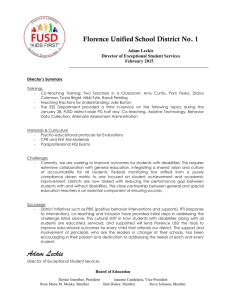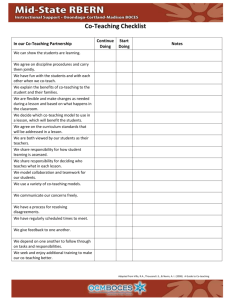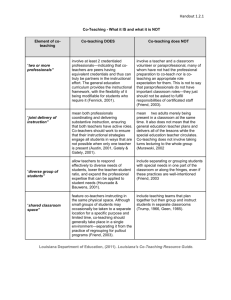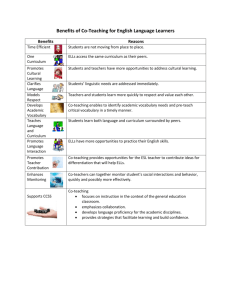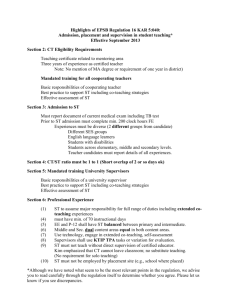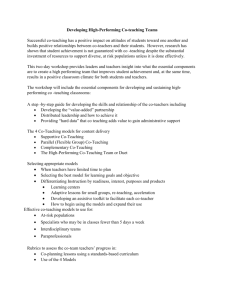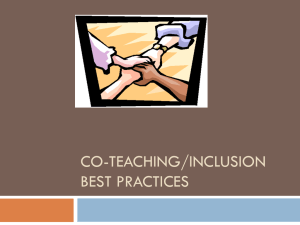Co-Teaching Presentation
advertisement
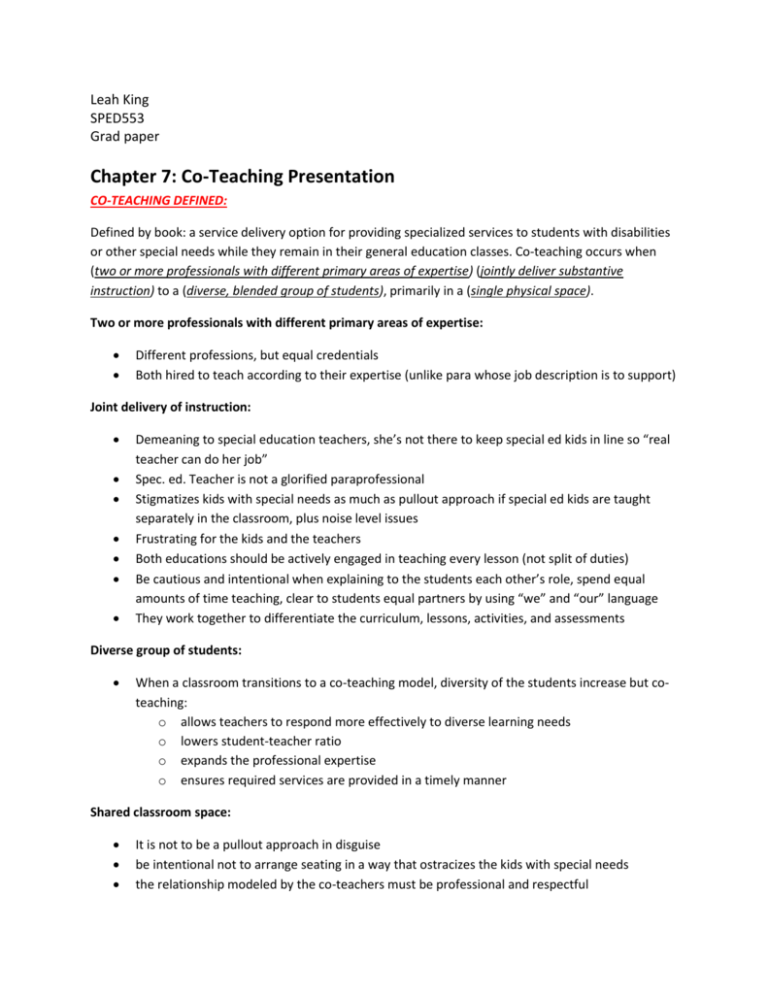
Leah King SPED553 Grad paper Chapter 7: Co-Teaching Presentation CO-TEACHING DEFINED: Defined by book: a service delivery option for providing specialized services to students with disabilities or other special needs while they remain in their general education classes. Co-teaching occurs when (two or more professionals with different primary areas of expertise) (jointly deliver substantive instruction) to a (diverse, blended group of students), primarily in a (single physical space). Two or more professionals with different primary areas of expertise: Different professions, but equal credentials Both hired to teach according to their expertise (unlike para whose job description is to support) Joint delivery of instruction: Demeaning to special education teachers, she’s not there to keep special ed kids in line so “real teacher can do her job” Spec. ed. Teacher is not a glorified paraprofessional Stigmatizes kids with special needs as much as pullout approach if special ed kids are taught separately in the classroom, plus noise level issues Frustrating for the kids and the teachers Both educations should be actively engaged in teaching every lesson (not split of duties) Be cautious and intentional when explaining to the students each other’s role, spend equal amounts of time teaching, clear to students equal partners by using “we” and “our” language They work together to differentiate the curriculum, lessons, activities, and assessments Diverse group of students: When a classroom transitions to a co-teaching model, diversity of the students increase but coteaching: o allows teachers to respond more effectively to diverse learning needs o lowers student-teacher ratio o expands the professional expertise o ensures required services are provided in a timely manner Shared classroom space: It is not to be a pullout approach in disguise be intentional not to arrange seating in a way that ostracizes the kids with special needs the relationship modeled by the co-teachers must be professional and respectful RATIONALE FOR CO-TEACHING: (makes the following feasible) Legislation: Free Appropriate Public Education (FAPE) and Least Restricted Environment (LRE) high quality education for all students whether gifted or struggling and everything in between within the general education classroom equal access to the same curriculum through differentiation and learning alongside peers Response To Intervention (RTI): both teachers can work together to more effectively provide appropriate intervention within the three-tiered approach. If one records data while the other teaches, they will be more prepared when they meet with the RTI team less fragmented instruction – if a student has to leave the classroom for intervention, he/she will miss out on instruction that the other students are receiving Inclusion: embraces and values diversity within the classroom and in the community puts the focus on everyone’s abilities rather than excluding those with disabilities Beneficial for teachers: Special education teacher does not have to master the curriculum content, but can provide differentiation expertise to meet the needs of all students, including those whom do not have a disability General education teacher does not have to master the skills of working with students with disabilities In other words, they learn from each other as they work together as a team CO-TEACHING APPROACHES: One teaching, one observing: Educators must exchange rolls, so the students understand that the teachers are professional equals and it allows both teachers to become better acquainted with the needs of the students and the teaching style of the other teacher Educators need to jointly decide which students to observe and the observation style (for example anecdotal recording, frequency, duration, latency, interval, or time sampling) and they need to jointly make instructional decisions based on the observation results Station teaching: Content is divided and each teacher is responsible for planning and teaching their part of the content. The instruction is delivered at separate stations and additional stations would be used for peer or para tutoring or for independent work. Benefits are: equal distribution of work, lower student-teacher ratio, both teachers have opportunity to teach all students Not appropriate with sequential content or if one of the teachers has an extremely loud annoying voice Several strategies can be implemented to address noise and movement Parallel teaching: Instruction is planned together, but the class is split in half Appropriate for test review and discussions or when half the class is reading material at an increased or decreased level of difficulty Issues include: if one teacher better prepares the students for assessment. Consistency of instructional content, delivery, pace, and assessment are essential. Alternative teaching: One teacher provides instruction for a small group while the other teacher provides instruction to the large group that those in the small group can afford to miss Used for skills assessment, pre-teaching, re-teaching, and enrichment Group membership must be fluid to avoid stigmatization Teachers must alternate from small and large group instruction Teaming: Both teachers are engaged in the delivery of instruction at the same time, i.e. one presenting while the other illustrates Teachers must mesh teaching styles and really click, otherwise students will sense any tension Of all approaches, requires the most trust and commitment, but if effective can be the most rewarding because it engages the students more and teachers take more risks than if they were teaching on their own. One teaching, one assisting: Common approach because planning time is scarce it doesn’t require a lot of joint planning Should only be used if it isn’t a distraction to kids and it’s the only appropriate approach due to the nature of the content COLLABORATION: As it pertains to co-teaching: Co-teaching is not collaboration, co-teaching is most effective when both teachers approach it with a collaborative style Shared goal = meeting the educational needs of students with diverse learning abilities Collaborate on design, delivery, assessments, and interventions Plus following topics should be thoroughly discussed in order to maintain a collaborative relationship Philosophy and beliefs: Do they agree on expectations that all students learn the general curriculum Beliefs about the right of all students to experience success and how that occurs Teachers’ roles in and responsibilities for student learning Alternative ways for students to demonstrate what they have learned (differentiating assessment and scoring criteria) Acceptable levels of noise and movement Classroom practices or rules (raising hand, repeating instruction, etc) Parity signals: Both teachers’ names on board Both teachers’ signatures on correspondence to parents Desk or storage space for both teachers in classroom Shared teaching approach Shared responsibility in grading Classroom routines: Discuss and agree upon the routines and then both adhere to them so that the student experience consistency Discipline: Good cop bad cop is not appropriate. Give example of Alex’s “co-teacher” Consistent rules, expectations, and consequences Decide who will intervene and when Feedback: Feedback is absolutely necessary (both good and bad). Discuss and decide ahead of time when and how feedback will be delivered, adhere to the agreement, and be receptive Noise: Talk about noise tolerance levels and potential signals to indicated when the noise level is breaching the tolerance level and how to bring the noise level down once it has escalated Pet peeves: Examples: not putting supplies away, interrupting during instruction, or over powering perfume. Whatever they are, talk about it and don’t personalize it. It is vital to discuss these matters before and also to revisit them occasionally for a check up. CO-TEACHING DILEMMAS: When needs of kids with EBD interfere with special education teacher ability to lead instruction: Not only does the special education teacher take on an equal role in delivering instruction, gen ed teacher also needs to take on role of special education teacher. Seek out input from administrator if this issue continues When gen ed teacher thinks he/she is being relieved of duty to accomplish other tasks (grading papers, lesson planning, etc.) Co-teaching needs to be defined and explained to gen ed teacher and involve supervisor of problem persists When gen ed teacher shoulders all planning, instructional, and grading responsibilities Co-teaching roles and responsibilities need to be clearly defined and communicated CO-TEACHING ISSUES FOR ADMINISTRATORS: Co-teaching is a service delivery model that addresses the demands of inclusion, RTI, and the diverse learning needs within a single classroom. This model is absolutely contingent on strong administrative support, especially when it comes to planning time, class structure, and scheduling. Caseloads / class size: Special ed teacher has a huge case load leaving him/her any time to co-teach Extra large classes restrict the ability to group students because lack of space and increased noise Distribution of students with special needs across classes / sections: Students with disabilities need to be strategically placed in classes. If spread out too sparingly, special ed teacher cannot co-teach in a large number of classes, if grouped all together, it can negatively impact instruction Co-teaching within the context of other service models: Some specialist use a pullout model (speech/pathologists) while others (spec. ed.) use co-teach model. Gen ed teacher can get frustrated if scheduling isn’t done appropriately Administrator needs to set expectations up in advance and have specific protocol for resolving issues Teacher and specialist schedules: If gen ed teacher has to co-teach with more than one specialist, the planning and collaborating can get burdensome Ample time needs to be allotted by administrator for planning STRATEGIES FOR PLANNING: Making / Using Time: It’s never enough time so use what you have wisely Stay focused / don’t get off topic and chatty Have an efficient system for planning (will evolve and become more efficient over time): this system could include clear expectations of protocol (timeliness, communication, who needs to prepare what prior to meeting), everyone needs to come prepared, have an agenda, and clear instructions for each person’s responsibilities following the meeting Using technology is another option. The book suggests wiki pages. I think the formatting features are clumsy and glitchy, so I would suggests something like dropbox or another shared platform that allows the use of shared documents using actual Microsoft software. Administrator or principal makes time through: extended lunch planning time, paying two hours extra pay outside of contract day or having two hour count toward continuing professional development credit, early release or late start days for students, a once a week collaboration hour where students are scheduled to be in a homeroom and then the other class periods for that day are shortened slightly Use of substitutes: A substitute that rotates to relieve teachers for collaboration meetings which are maintained on a master calendar or schedule Depending on the responsibilities and schedule of the special education teacher, a second substitute might be needed to relieve the spec ed teacher To work, funding needs to be available to employ substitutes and substitutes need to be qualified professionals who can manage this role Alternatives for class coverage: If funding or qualified subs are not available, professionals within the school can cover for each other whether it be the principal, asst principal, other specialists or teachers with an open hour. Instructional strategies that facilitate planning: Gen ed teacher instructs class of special ed teacher’s role once the spec ed teacher enters the room. This informs the students and the special ed teacher of the expectations A similar approach is to have the students review in open dialogue in the presence of the spec ed teacher so she knows how to jump in and what the students are working on

